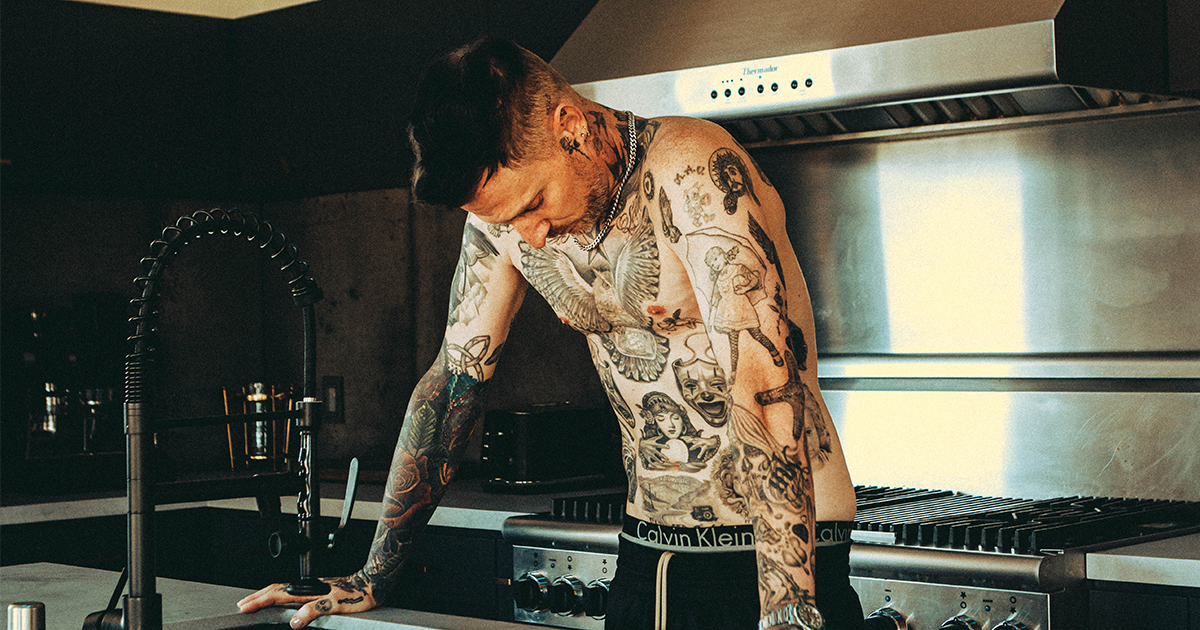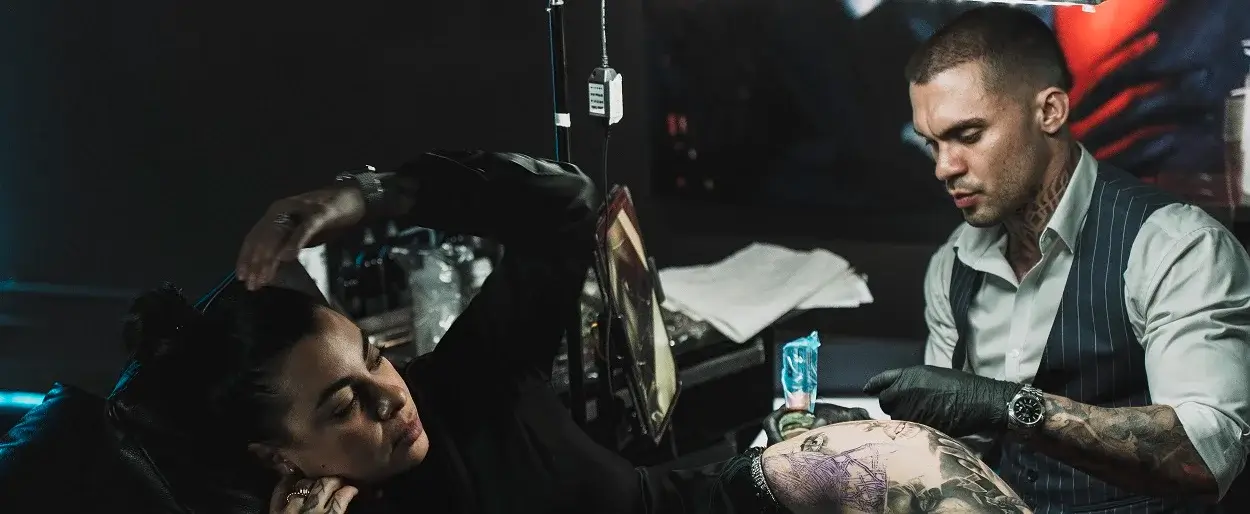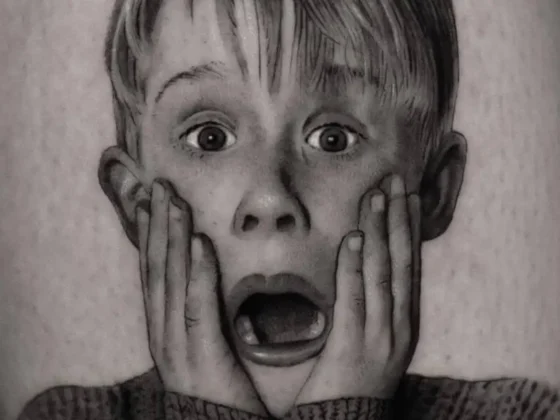Inked Mag Staff
September 30th, 2022
Basting in Art
Listen in on Dominic Ciambrone and celebrity chef Michael Voltaggio as they discuss how art can be found in unexpected places, the perfect kitchen shoe and more.
Interview by Dominic Ciambrone
Photos by Bryam Villacres
Before we get into everything about your life, let’s talk about how we first connected because it’s pretty closely related to your overall story. You came to me with the idea to customize your Balenciaga Crocs. What’s that boot called?
I don’t even know.
Everyone just calls it the Kanye boot because he wore them so often.
When I saw Kanye wearing them I said, “OK, that’s not really a daily driver.” They were tight, but if I wear these things out every day people are going to come up to me and ask, “When are we going fly fishing?” I thought they would be the perfect boot for work. They’re rubber, they’re heavy, they’re high, they’re safe for every element in the kitchen. But they’re not that practical [otherwise]. So when I brought them to you I was like, “Can we just chop ’em down a little bit and turn them into lowriders?” It accomplished everything I wanted to from a practical point of view but also from a fashion point. It was the ultimate chef shoe.
I feel like for many years chefs have been underserved in the shoe department. I love that you wanted to take something cool and make it even cooler so you can wear it in the kitchen.
And out of the kitchen. A lot of fashion is inspired by industrial workwear, like the trends with old military clothes and things like that. I thought the idea of a chef uniform could also be part of that workwear inspiration that inspires fashion. We work 10, 12, 16 hours a day on our feet, so it starts with the shoe. What we did with the boots was figure out how we could make something I could wear to work and wear after work, but also inspire other companies to look at that design and, I hate to say it, but knock it off and do something that’s more accessible.
In the kitchen, outside of knives, shoes are one of the first things chefs will gravitate towards trying to represent themselves. I think that’s kind of tight, you walk into a kitchen and you see the same footwear trends in the kitchen that you see outside of the kitchen.
This seems like a good place to ask how you ended up working in kitchens in the first place.
I started my career working at the Holiday Inn at the Francis Scott Key mall in Frederick, Maryland, at the age of 15. I started as a busboy and my brother was the sous chef. We were working at the same hotel and he was in the kitchen while I was out cleaning tables. I thought that was kind of fucked up. The people you want to hang out with are in the kitchen, even at the Holiday Inn. My brother scheduled me to work in the kitchen on a Sunday—told me on a Saturday—and scheduled himself and the other sous chef off and didn’t tell the executive chef. I showed up in a chef’s uniform and the guy looked at me and goes, “What is this, fucking Halloween?” That was the start of my hazing period. He gave me shit for a year and a half straight, doing everything he could to talk me out of getting into this industry. Fast forward to today. I took that as a challenge: I’m going to do this, and I’m going to do it at a higher level than you’re even saying is possible because I like doing this.
I think it’s motivating when someone tells you no. It sparks something inside of us.
The defiance. It’s similar to getting tattooed. A lot of it is very anti what I’m supposed to do, I’m going to do what I want to do. I got tattooed and started cooking in the same year.
What was your first job in the kitchen?
First I had to run everything back and forth on the Sunday buffet, then I got to start making the food. The first thing I got to make was one of those huge poached salmon platters with all the decorations made out of vegetables, like a carrot turned into a palm tree trunk with an upside-down green pepper. Carving a radish into a mouse. I was building these scenes out of food and thought, “Damn, this is kind of tight. I’m making art out of food.” Visually I was into it, then I started getting into flavors.
They’d tell me I’m making the pasta special. I’m like, “You’re going to let me create something, then you’re going to put it on the menu and sell it in this restaurant?” They’re like, “Yeah, what do you have?” So I’d grab some pepperoni and dice it up, throw some heavy cream in there, add some tomatoes and try to make pepperoni pizza pasta and things like that. I couldn’t believe I was allowed to just go into this kitchen, take a bunch of ingredients and put them together the way I like, and then you’re going to go and sell it to other people. I wanted that to be my career.

You had mentioned that you were making art. Is there an artistic side to being a chef?
My discipline is that I’m a chef, that’s my profession, but I mix emotion with my professional career. I always wanted to be a creative and do something artistic. I can’t draw, I can’t paint, I can’t sing, I can’t do all that stuff. But when you mix all the elements together of what I do, there is some art in that. From designing a restaurant alongside interior designers, who I think are artists, we work closely to transform a space. There’s art to curating the whole experience—the music, the furniture, the food, the drinks.
Then when you break it down to individual dishes, I approach everything I cook with an artistic approach more than a practical one. That’s because of the type of food I have cooked for so many years, people think I’m going to be doing something with some surprise element, so then I feel pressure to do something artistic so people won’t say things like, “Oh, he just gave me a bowl of pasta.” If you can make that bowl of pasta taste good, you can find the art in just the flavor of it.
Little things. If you’re roasting a rack of lamb in a pan and basting it with butter… On a cooking show that I was judging I saw a little kid drop an anchovy into the pan and start basting the lamb with this butter. I tasted that lamb and was like, “Wow, this 10-year-old kid just taught me something.” That anchovy put a subtle flavor into the lamb people didn’t expect, that is art.
It’s interesting how you say flavor profiles are an art, I haven’t heard it put like that. I got my creativity from my dad, who’s a chef. The way he cooked, the way he got the flavors into the food and how he wanted the restaurant to look. Chefs have so much creativity, it’s cool to see how you can create art with flavor.
Take something like white chocolate and caviar. You put those two things together—one is so sweet while the other is so salty—and when you hear that it makes no sense. But when you put it in your mouth, it works. I think those moments are the ones I try to create. I want people to be like, “Wait. You put what and what together and it tastes like this? Huh.”

Let’s close out by talking about the art you wear on your body. Earlier you showed me your first tattoo—a shamrock you got at 15—and mentioned the connection between tattooing and kitchens. Can you elaborate on that?
I think with any job where you wear a uniform, there’s very little room for you to express yourself. That’s why I think people go for shoes, tattoos, etc. For years if you worked in a luxury environment you weren’t allowed to have visible tattoos. I think [by so many chefs having tattoos] we forced it to become normal and it became normal. If they have the skill set for the job, how are we going to discriminate against that? I’ve had an ongoing relationship with Williams-Sonoma for many years. One of the most memorable experiences I’ve had with them was when I went to one of their stores and a staff member said to me, “Thank you for being in our catalog. Once you did that it violated the dress code and now we get to express ourselves a little more freely at work.” He had his sleeves rolled up and he showed me his tattoo, he was super stoked. I never even thought about that. I don’t understand why people were so turned off by the idea of a tattoo. Why would you look at a person differently because they have tattoos?
It’s come a long way. When I first started getting tattoos part of it was so it forced me to figure out how to make my way without getting a regular job.
I blasted this thing on my neck consciously knowing I would have to go out and interview for jobs and take meetings trying to convince multimillion-dollar hotel companies I should be a part of their portfolio. It made me focus more on making sure that if they could see past all this, I’ll have something there for them. The more tattoos I got, the more I focused on my education, the more I focused on my skill set, the more I focused on what I could physically and mentally do so that the stigmatism of tattoos would go away.
And from the story you told us previously, we’ve seen it happen. Thank you.
Editor's Picks
Bridging Classical Art and Modern Tattooing
Esteban Rodriguez brings the discipline of classical fine art to the living canvas of skin, creating hyper-realistic tattoos that merge technical mastery with emotional depth.
Show Your Ink Fashions Brings Custom Style to Tattoo Culture
Show Your Ink Fashions creates custom shirts designed to showcase your tattoos as wearable art, blending fashion with personal expression.
The Ultimate “Superman” Tattoo Roundup: Just in Time for Superman’s Return to Screens
With Superman’s big return to theaters, fans are revisiting some of the most iconic ink inspired by the Man of Steel.














